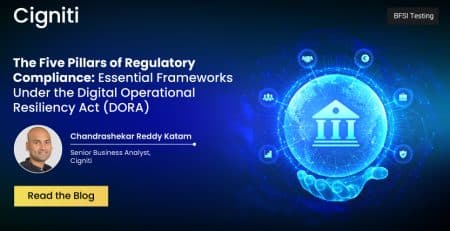This is how digital is transforming Retail Banking
Retail banking does not remain untouched from the digital wildfire. As a matter of fact, customer-first banks are en–route their transformational journey to serve their digital-first consumers. The findings of a Business Insider report revealed a tremendous increase in the active digital customers in the third quarter of 2019 as compared to 2018.
In the last ten years, there is an inverse relationship pattern identified between the deposit value at the top 25 U.S. banks and their combined branch footprint. While the deposit amount has doubled over the past decade, their branch footprint has reduced by 15%. Earlier, any shrinkage in the branch network would have been correlated to a bank’s downfall or economic recession. Today, the shrinkage is usually a reflection of enhanced digital capabilities.
In the words of Jerome Powell, Chair of the Federal Reserve, “mobile devices, high-speed data communication, and online commerce are creating expectations that convenient, secure, real-time payment and banking capabilities should be available whenever and wherever they are needed.”
The customers increasingly expect intuitive, frictionless, and connected banking platforms. Until recently, the banking sector was playing defense against the approaching digital wave and fintech start-ups. However, as the customer demands shift, retail banks are looking to adopt tactics to fulfill their expectations. Customer base for digital banking is on a constant rise. Bank of America noted a 5% year-over-year increase in its digital banking users with 28.7 million active users. For the US Bank, 67% of the customer transactions in the 3rd quarter happened digitally. JPMorgan Chase has registered a 12% year-over-year increase with 51.8 million active digital customers. It is leveraging its digital capabilities to enhance consumer engagement and has recorded 2 million digitally-opened checking and saving accounts.
The Retail Consumer Banking Survey report showed a precipitous decline in the percentage of US banking customers who prefer traditional forms of transacting from 38% to 26% in two years. Customers do not want only digital means of transacting, but an omni-channel experience with digital-first strategy. This digital inclination is borderline forcing retail banks to undergo a massive transformation.
Taking customer mindshare into perspective
McKinsey defines customer mindshare as the combination of products, services, functions, and access that creates an environment that encourages greater engagement between a bank and its customers. Customer mindshare is an aggregate metric that encompasses four factors, namely, physical footprint, digital maturity, share of voice, and customer experience.
Despite the digital hullaballoo, customers rely on face-to-face interactions and physical branch visits for the complex parts of banking. Even the banks are not fully evolved to carry out tasks such as credit and loans through digital channels.
Customers want the luxury of choice. They expect their banks to provide them multiple channels of transacting and for those channels to work seamlessly with each other. By having a physical presence in the form of branches or ATMs and a digital presence through mobile and web applications, banks can significantly improve their customer engagement and adoption rate.
Unbundling old relationships
Customers’ loyalty today does not lie with a logo, but a service. This means that customers will shift their liking based on the level of service they get from a brand. 40% of the US households have a deposit account in more than one financial institution.
Banking being a high-risk business required high trust and credibility. This was one of the main reasons why there were high barriers for new industry entrants and why the incumbents majorly enjoyed unwavered dominance. This was also a reason the ‘defense-mode’ attitude of incumbents usually worked in their favor. However, the scenario is changing with growing influence of big tech over legacy institutions.
The closely bundled relationship of one-on-one retail banking is now loosening or unbundling. Customers are forming their own customized bundle of various services from the best in the industry. This may include credit card services from one institution and insurance from another.
Invasion of big tech in banking
Big tech companies such as Amazon, Alibaba, Google, Facebook, and Tencent are invading the banking business with their big data and analytics capabilities. With a platform business, these big tech companies are looking to offer low-cost banking structures which may prove a huge threat to the incumbents.
A study of over 3000 banks globally revealed that larger institutions are more efficient in terms of cost-to-asset as well as cost-to-income ratios. While big techs pose a danger to the efficiency and scalability of such institutions, the wind might just blow in the favor of incumbent banking organizations.
With advancing technologies such as robotic process automation, machine learning, cognitive AI, retail banking institutions can effectively optimize their processes and reduce their costs by 30-40%. Additionally, they can leverage on their established reputation to develop a trustworthy digitally-sophisticated ecosystem for their customers at much lower cost than their competitors.
The shift from physical to digital and application of critical analytic algorithm on the available customer data can allow these institutions to offer targeted, personalized, cutting-edge experiences to users.
In Conclusion
In order to succeed in the transformational journey, retail banks will need to capitalize on the available data to develop innovative solutions and features for their customers. They will require a clear vision and an agile strategy. The first step in the direction is to obtain buy-in from the C-suite, which will enable them to steer their organization toward a shared objective. To drive higher deposits and better customer engagement, retail banks need to extend value to their customers through out the journey.
For retail banks, digital transformation essentially requires a customer-experience transformation strategy. Although the transformation is the need of the hour, it is highly tricky to get it right.
Cigniti’s dedicated Banking Domain Competency Group (DCG) furthers our thought leadership in the Banking functional and technology landscape. It facilitates effective delivery through an experienced pool of top-quality test consultants who are industry SMEs and certified professionals.
Cigniti has successfully delivered testing services for nearly 20 years, implementing its Test Center of Excellence, delivering Managed Testing Services, and providing end-to-end testing services for leading banking companies across multiple geographies. Get in touch with us to know more.





Leave a Reply